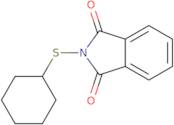N-(Cyclohexylthio)phthalimide
CAS: 17796-82-6
Ref. 3D-FC59864
| 25g | Ausgelaufen | ||
| 50g | Ausgelaufen | ||
| 100g | Ausgelaufen | ||
| 250g | Ausgelaufen | ||
| 500g | Ausgelaufen |
Produktinformation
- Cyclohexyl N-Phthalimidyl Sulfide
- 1H-Isoindole-1,3(2H)-dione,2-(cyclohexylthio)-
- 2-(Cyclohexylsulfanyl)-2,3-dihydro-1H-isoindole-1,3-dione
- 2-(Cyclohexylthio)-1H-Isoindole-3(2H)-Dione
- 2-(Cyclohexylthio)-1H-isoindole-1,3(2H)-dione
- 2-(Cyclohexylthio)isoindoline-1,3-dione
- 2-Cyclohexylsulfanylisoindole-1,3-dione
- 3-(2H)-dione,2-(cyclohexylthio)-1H-Isoindole-1
- Accitard RE
- Anscorch CTP
- Mehr Synonyme anzeigen
- Anti-scorching Agent PVI
- Antiscorching Agent CTP
- Antiscorching Agent PVI
- Antiscorching Agent PVI(CTP)
- CTP
- CTP (chinese inhibitor)
- Cp29242
- Ctp-Pvi
- Ctpi
- Cyclohexylthiophthalimide
- Duslin P
- Duslin PP
- N-(Cyclohexylthio)phthalimide,SANTOGARD PVI-100%
- N-Cyclohexy(Thio)Phthalimide(Pvi)(Ctp)
- N-Cyclohexy(thio)phthalimide
- N-Cyclohexylsulfenylphthalimide
- PVI
- Phthalimide, N-(cyclohexylthio)-
- Pilgard PVI
- Retarder CTP
- Rhenogran CPT 80
- Rubber Antiscorching Agent CTP
- Rubber Antiscorching Agent PVI
- Santogard PVI
- Santogard PVI-DS
- Santogard(R)
- Santogard(R)Pvi
- Santogardpvi
- Santogardpvi-Ds
- Sf 205
- Tert-Butoxy(Chloro)Diphenylsilane
- Vantard Pvi
- Vulkalent G
- Vulkalent P
N-(Cyclohexylthio)phthalimide is a sealant that is used in vitro for the protection of metal surfaces. It has been shown to have high resistance against metal corrosion and oxidation catalysts, which may be due to its ability to form crosslinks with fatty acids. N-(Cyclohexylthio)phthalimide can also be used as a crosslinker in polymers, such as epoxy resins, polyurethanes, and polyesters. This compound is genotoxic and can induce hamster V79 cells to enter S phase of the cell cycle.
N-(Cyclohexylthio)phthalimide reacts with nitrogen atoms on the surface of metal hydroxides to form a stable sealant that resists corrosion and oxidation catalysts. The mechanism by which this reaction occurs is not well understood, but it has been suggested that it involves a nucleophilic attack by an oxygen atom on the carbon-sulf





